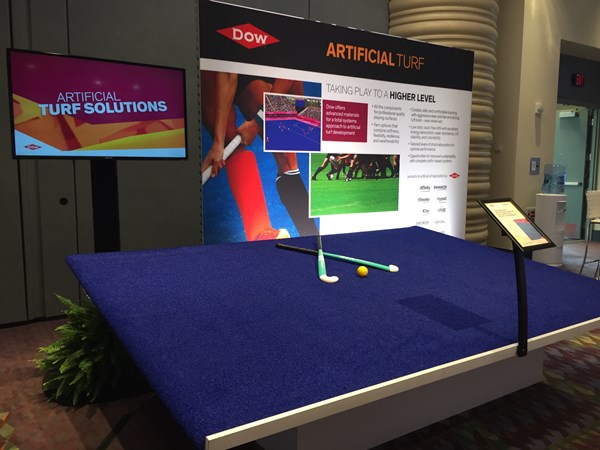Dow Chemical to supply the artificial turf at Rio 2016
Dow is working with Polytan STI, a manufacturer and supplier for outdoor and indoor sports surfaces, on the artificial turf for the hockey players at the Rio 2016 Olympic Games.

Dow showcased its artificial turf at NPE2015.
Plastics and sports: always a fun combination. The latest example of this was The Dow Chemical Co.’s announcement during NPE2015 that the artificial turf, based on the company’s polyethylene (PE) and polyurethane (PU) technologies, will be the official playing surface for hockey competitions during the Rio 2016 Olympic Gamesat the Deodoro Olympic Park.
Dow is working once again with Polytan STI, a manufacturer and supplier for outdoor and indoor sports surfaces, on the artificial turf for the world’s best hockey players in Rio. Dow and its customer worked together on London 2012’s Riverbank Arena.
For nearly 40 years, the International Hockey Federation (FIH) has been playing on synthetic and natural grass surfaces. However, the FIH has seen how the game has become faster, more technically skillful and entertaining because of the synthetic surfaces. This has progressively led to the increased use of artificial turf surfaces at all elite level competitions.
Two pitches and one warm-up area at Deodoro, as well as two additional pitches to be built at the Federal University of Rio, will benefit from a comprehensive playing surface that consists of specific high-performing materials formulated together in multiple layers. The surface system is designed to deliver enhanced durability for increased pitch life, and a consistent field-of-play throughout the busy Olympic competition schedule.
“It is designed to be durable as there must be consistent play from game to game,” Jackie deGroot, Sr. Development Scientist at Dow, told Plastics Technology.
The production of synthetic turf is a highly elaborated process, according to Dow. The system begins with the production of the master batch and the yarn for the turf. The subsequent tufting and backing process provide a strong turf bind, even when the surface is wet. For the upper surface layer, the polymer yarn provides wear resistance and energy absorption, combined with softness and speed. The complete turf system, including embedded shock pad properties, provides stability, durability, shock absorption and force reduction properties for the benefit of the players and the game.
The internationally-certified artificial turf system offers colorability, enabling customized aesthetics and design for the playing surface. London 2012 marked the first Olympic hockey competition in history to be played on blue and pink turf. The blue color enabled players, officials, spectators and the media to keep their eyes on the ball more easily, because it provided a high level of contrast against the yellow ball and white lines.
“Another big benefit of turfs over natural grass is the sustainability factor,” deGroot said. “There’s not a lot that needs to be done to maintain it, unlike natural grass and there’s also the huge savings of water.”
The STC estimates that a typical lawn of 1,800 square feet can require 56,000 gallons of water for maintenance each year. The artificial turf systems are low maintenance and require no need to irrigate, mow or chemically treat it.
















.png;maxWidth=970;quality=90)